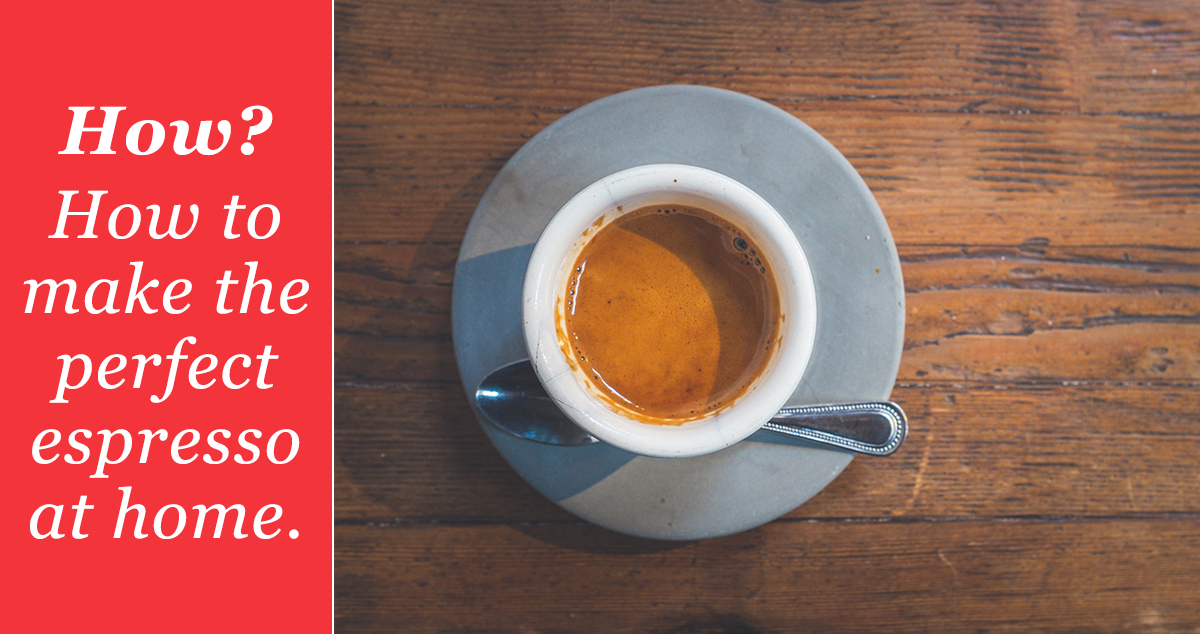
How to make the perfect espresso at home using a traditional espresso machine
So you’ve spent hundreds, or thousands, of pounds on a home espresso coffee maker, but how confident are you in your home barista skills? Our co-founder David has been wholesaling fresh coffee for almost 20 years and in this capacity he has trained hundreds of Baristas to make a perfect espresso shot. Here he shares his top tips for making the perfect espresso at home.
- Use fresh whole beans – buy fresh beans from a specialist supplier who knows how old the beans are and when they were processed or roasted. Fresh beans produce a better espresso, which should be viscous and full of flavour with a rich crema. David’s rule of thumb is beans should be used four days to three weeks after roasting for optimal flavour.
- Finely grind your beans – the fineness of your grind is one parameter that determines the rate of extraction, which in turn affects flavour. If the grind is too fine, over extraction is likely as the water passes too slowly through the dense coffee and a burnt or ashy flavour may result. If ground too coarse, the espresso will taste watery and thin, as the water will pass through too quickly without extracting all the oils and flavour in the coffee.
David suggests the perfect texture for an espresso grind is “like flour with a little bit of gritty salt or sand through it.” The ground coffee should clump readily when it’s squeezed between your fingers.
- Clean and dry - make sure there is no moisture, or old coffee grinds, in your porter filter and basket. If fresh coffee comes in contact with moisture, it starts extracting too early. Use a clean cloth to dry and clean these parts.
- Don’t forget to tamp – David insists home baristas should invest in a tamper to compact their coffee evenly into the basket. Fill the basket about three-quarters full with ground coffee (usually 7 grams for single shot & 14 grams for double shot). Tap the basket on your counter to collapse the coffee and ensure the basket is filling evenly. To tamp, grab the tamper like a door knob and leans into it from above with a straight arm. If you turn the basket upside down after tamping, the coffee should stay put.
After tamping, the basket should be no more than four-fifths full. If coffee sits too hard-up against the machine's shower screen, you may get an uneven extraction; too far away and the espresso may taste muddy. David uses the analogy of a watering can; water poured from too great a height will hit the soil (coffee) too forcefully and churn it up, resulting in mud.
- Purge your machine - run some water through it just before making your espresso to ensure it’s as clean as possible.
- Measure the shot – there are many different rules baristas favour to ensure consistent and well-balanced espressos. David advocates, 7-10grams of coffee, for a 4oz/9cl shot of espresso with an extraction time of 21-25 seconds.
- Make your shot – initially your machine should deliver drips before a steady stream of espresso. Fresh coffee will be slightly viscous and will almost look like its springing back up because of the oils in the beans. The shot should have a nice crema on top. This is the lighter, fluffier substance that sits on the surface. Crema looks like tiny bubbles and is reddish-brown or hazelnut in colour. The colour should be consistent from the middle outwards. An inconsistent colour usually indicates over extraction, whilst a dull colour indicates under extraction. A Lack of crema is a sign your coffee beans are past their best.
For tops tips on making great tasting coffee with a bean to cup machine and other popular brewing devises, visit our Brew Guides.


